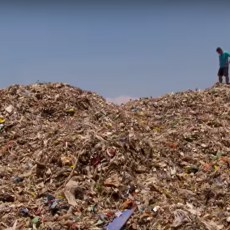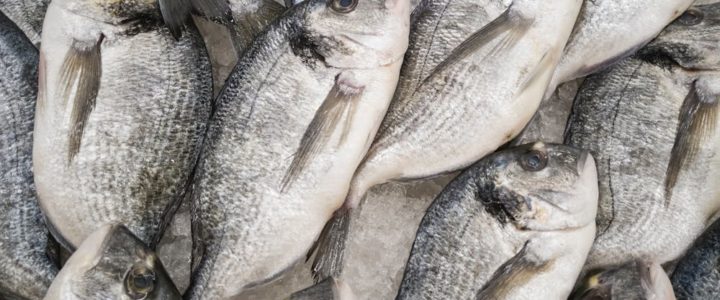
Global seafood consumption has more than doubled in the last 50 years, with demand reaching a staggering 143 million metric tonnes. This number represents only the seafood destined for human consumption. If we include seafood meant for other uses, like animal feed and pet food, that demand number rises to 154 million metric tonnes.
Traditionally, seafood is caught in the wild with nets, lines, trawlers, and other equipment. But as demand has increased, overfishing — catching fish faster than stocks can replenish — has decimated fish populations and caused the breakdown of marine eco-systems.
Globally, the number of overfished stocks has tripled in half a century, and today, fully one-third of the world’s assessed fisheries are currently pushed beyond their biological limits, according to the Food and Agriculture Organization of the United Nations.
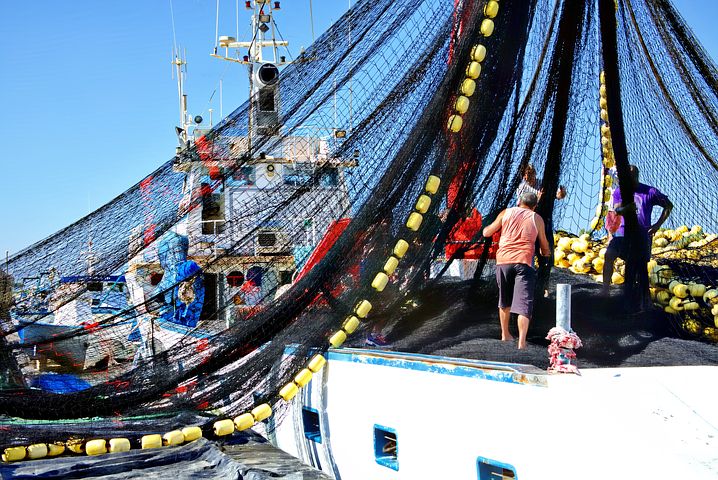
Overfishing is closely tied to bycatch—the capture of unwanted sea life while fishing for a different species. This, too, is a serious marine threat that causes the needless loss of billions of fish, along with hundreds of thousands of sea turtles and cetaceans.
Atlantic and Pacific bluefin tuna, Atlantic cod, Pacific halibut and orange roughy — just to name a few of the fish you’ll commonly see on menus — are considerered over-fished. More than 90 species of marine fishes in Europe’s waters are threatened with extinction due to overfishing; the Goliath grouper is ciritically endangered; and the largest freshwater fish species in the world is now extinct because of human activity. The Chinese paddlefish, sometimes called the “panda of the Yangtze River,” was just a few months ago found to have been lost to overfishing and habitat destruction.
If overfishing continues, more species will be driven to extinction and aquatic ecosystems will continue to collapse.
Enter in aquaculture.
Aquaculture is the controlled process of cultivating aquatic organisms, especially for human consumption. It’s a similar concept to agriculture, but with fish instead of plants or livestock. Aquaculture is also referred to as fish farming. The seafood that you find at your local grocery store is likely labeled as farmed fish. Aquaculture can happen all over the world, and it does: in coastal ocean waters, freshwater ponds and rivers, and even on land in tanks.
According to the United Nation’s Food and Agriculture Organization, aquaculture now represents more than half of global human seafood consumption.
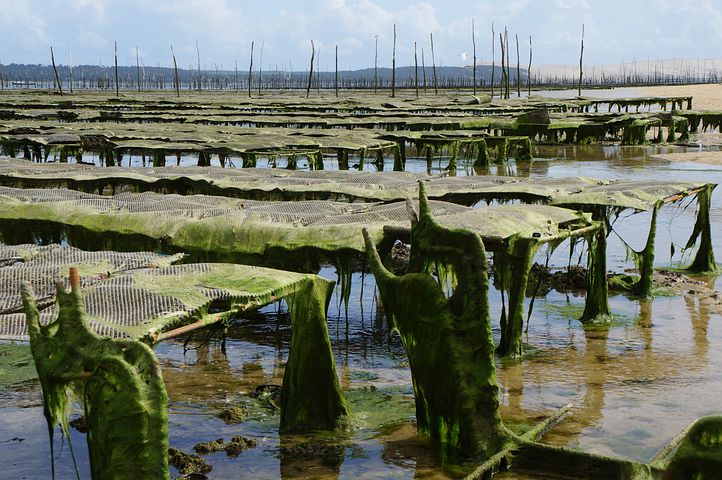
Aquaculture can be an environmentally responsible source of food and commercial products, help to create healthier habitats, and be used to rebuild stocks of threatened or endangered species. The farming of bivalve mollusks, such as clams and oysters, removes excess nutrients from the water by feeding on algae and particulate matter. This helps maintain good water quality and minimizes the loss of critical oxygen. While farmed shellfish are growing, they spawn and help to reseed wild shellfish beds. Due to their unique structure, bivalve mollusks provide habitats and hiding places for other organisms, adding to the biodiversity of the marine ecosystem. These impacts are so important that projects like Billion Oyster in New York City are restoring oyster and clam populations to rebuild ecosytems.
Not only is aquaculture necessary since the waters of the world cannot sustain the dietary needs of the Earth’s inhabitants without being depleted, it is also actually a more sustainable option in comparison to other farmed proteins. Seafood is highly resource efficient — it has the highest protein retention compared to chicken, pork and beef. It also has the lowest feed conversion ratio among the same forms of protein. And aquaculture has lower greenhouse gas emissions than other types of farming.
But much like agriculture, aquaculture comes with a host of negative issues for both enivironment and sealife.
Fish farms can cause many of the same problems as factory farms on land – waste, pesticides, antibiotics, parasites, and disease – and these issues are magnified because of the immediate contamination of the surrounding ocean water. Escape of non-native species can threaten other local species populations. The large amounts of waste produced by the fish must be removed regularly, and this may cause eutrophication of the surrounding water. Eutrophication is when a body of water becomes overly enriched with minerals and nutrients which induce excessive growth of algae. This process may result in oxygen depletion of the water body, causing damage to the entire ecosystem. And these fish need to be fed. They are often done so with pellets made from other less valuable wild fish, which can lead to overfishing of these species.
So, how can you make your most sustainable seafood choice?
First and foremost, learn where your seafood is coming from. If buying from a grocery store, check your labels. Look for the “Certified Sustainable Seafood” label from the Marine Stewardship council. This is for wild caught fish. Look for the Aquaculture Stewardship Council or ASC label on farm raised fish. This will tell you if the fish farm has met the standards for responsible aquaculture.
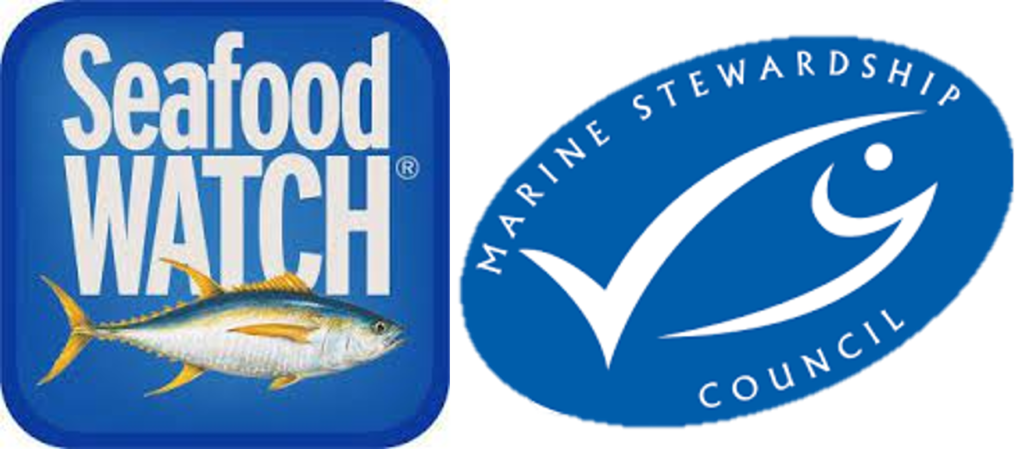
And get to know the Seafood Watch rating of the type of fish available to you. This will tell you which fish are abundantly available and harvested in sustainable ways. Green is a go, red is a no.
No label? No problem. Talk to your fish monger or your server if you’re at a restaurant. Ask them where your fish is coming from. If they can’t answer, the most sustainable option is to skip it.
As for the bigger picture beyond your plate, the United Nations has named Sustainable Development Goal #14 of the Paris Agreement: Life Below Water, with the stated intention to effectively regulate harvesting and end overfishing, illegal, unreported and unregulated fishing, and destructive fishing practices. The goal is to implement science-based management plans, in order to restore fish stocks in the shortest time feasible, at least to levels that can produce maximum sustainable yield as determined by their biological characteristics. Additionally, they will work too prohibit certain forms of fisheries subsidies which contribute to overcapacity and overfishing, eliminate subsidies that contribute to illegal, unreported and unregulated fishing and refrain from introducing new such subsidies, while recognizing that appropriate and effective special and differential treatment for developing and least developed countries should be an integral part of the World Trade Organization fisheries subsidies negotiation.
With an anticipated 10 billion people expected to inhabit the planet by 2050, the demand for animal protein will increase by 52 percent making sustainable and healthy approaches to feeding the world more critical than ever before.



